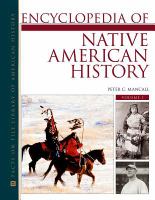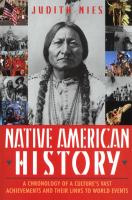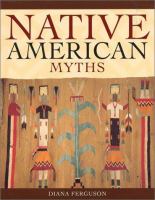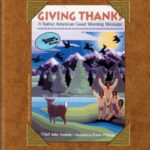LIBRARY BLOG
How November Became Native American Heritage Month
November is a time known for celebrating the year’s harvest or reflecting on our year’s accomplishments and being thankful for our successes and learning experiences. The holiday was sporadically observed since George Washington’s presidency, but it was not considered an official or regularly observed holiday until 1863 when President Abraham Lincoln declared the fourth Thursday in November to be the annual day of giving thanks. Later, in 1939 President FDR issued a presidential proclamation that moved the Thanksgiving holiday to the second-to-last Thursday of the month. This was in response to the holiday falling on the last day of the month that year which would result in a shortened Christmas shopping season. In order to keep the recovering economy flowing FDR changed the holiday, but for two years 16 states refused to accept the change, citing that the holiday is the last Thursday of the month. During this time the country celebrated two Thanksgiving holidays, one on the second-to-last Thursday and one on the last Thursday of the month. To clear up confusion in 1941 congress set a fixed date for the holiday making it the fourth Thursday of the month, which would take into account the years that November consists of five weeks. This holiday stems from the colonists who landed at Plymouth Rock, modern day Plymouth, Massachusetts, in 1620.
A group of colonists, commonly known as the pilgrims, began setting up a village in this area. These people spent 66 days crossing the Atlantic Ocean on a small ship called the Mayflower to seek out a new home where they can freely practice their faith. Others were drawn to the area for the prospect of land ownership in the new world.
Landing in September, most of the colonists remained aboard the ship throughout the winter, but they still suffered from exposure, scurvy, and outbreaks of contagious diseases. Only about half of the colonists and crew survived that tumultuous time. By March, the remaining settlers began moving ashore, which was when they met an Abenaki, Samoset, who was able to greet them in English. This was a shock to the colonists who were unaware of English-speaking natives. Interestingly, Samoset was a sagamore, a subordinate tribe chief, and he was able to learn English from fishermen who came to fish the bountiful area now known as the Gulf of Maine. After seeing the malnourished state of the colonists, Samoset returned some days later to the village with Squanto. Squanto, a member of the Patuxet band of the Wampanoag tribe, was also an English-speaker making him able to teach the colonists how to cultivate corn, extract sap from maple trees, catch fish in the rivers, and avoid poisonous plants. He also aided the settlers in forging an alliance with the Wampanoag, a local tribe, which would last for more than 50 years. Tragically, this remains one of the only examples of peace and harmony between European colonists and Native Americans.
After producing a successful corn harvest the following year, in November 1621, the colonists organized a celebratory feast inviting some of the colony’s Native American allies, including the Chief of the Wampanoag, Massasoit. This celebration, known as America’s first Thanksgiving, lasted for three days and has echoed into the traditions of the future. Without the help of the Wampanoag tribe, the first colony would have surely ended in disaster. It is due to the resourcefulness and knowledge shared by the Native Americans that allowed the first colony to succeed. The natives were able to teach the colonists not only how to harvest corn but also which wild plants were edible or poisonous, how to make natural medicines and remedies, and showed colonists which trails to follow. While this information has led to the eventual succession of the United States from Great Britain, it was never formally recognized by the United States government until 1986, when President Reagan proclaimed the first American Indian Week as November 23-30, 1986. This proclamation was made yearly by the acting president, but in 1990 under President Bush congress passed legislation which called on the president to proclaim November 1990 as “National American Indian Heritage Month.”
It was in Presidential Proclamation 6230 that George Bush paid tribute to the rich history and culture of the American Indian tribes. Each year since 1990 the president has proclaimed November the designated National Native American Heritage Month. Congress chose the month of November because this is generally the end of the traditional harvest season and a time of thanksgiving and celebration for Native Americans. It is also a time for all American people to honor the achievements of the native tribes and celebrate the rich and diverse cultures, traditions, and histories these tribes possess. In addition, November is a time to raise awareness about the challenges native people have faced in the past as well as in the present and how they have worked to conquer these challenges.
Recommended Books and Documentaries
References
- Clinton, William J. “Proclamation 6847–National American Indian Heritage Month, 1995.” Weekly Compilation of Presidential Documents, vol. 31, no. 44, Nov. 1995, p. 1971. EBSCOhost, search.ebscohost.com/login.aspx?direct=true&db=a9h&AN=9512181817&site=ehost-live.
- “Congress Establishes Thanksgiving.” Archives.gov, The U.S. National Archives and Records Administration, 25 July 2019, www.archives.gov/legislative/features/thanksgiving.
- “National American Indian Heritage Month.” Library of Congress, 24 July 2020, www.loc.gov/law/help/commemorative-observations/american-indian.php.
- “Native American Heritage Month.” National Congress of American Indians, W.K. Kellogg Foundation, 2020, www.ncai.org/initiatives/native-american-heritage-month#:~:text=November%20is%20Native%20American%20Heritage,important%20contributions%20of%20Native%20people.
-Emily Duplantis, Youth Services







